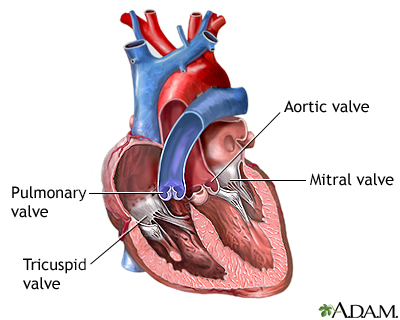Pregnancy SmartSiteTM
Chest sounds - murmurs; Heart sounds - abnormal; Murmur - innocent; Innocent murmur; Systolic heart murmur; Diastolic heart murmur DefinitionA heart murmur is a blowing, whooshing, or rasping sound heard during a heartbeat. The sound is caused by turbulent (rough) blood flow through the heart valves or near the heart. ConsiderationsThe heart has 4 chambers:
The heart has valves that close with each heartbeat, causing blood to flow in only one direction. The valves are located between the chambers. Murmurs can happen for many reasons, such as:
 There are several ways in which your health care provider may describe a murmur:
When a murmur is more noticeable, the provider may be able to feel it with the palm of the hand over the heart. This is called a "thrill" and means the murmur is grade 4 or higher. Things the provider will look for in the exam include:
CausesMany heart murmurs are harmless. These types of murmurs are called innocent murmurs. They will not cause any symptoms or problems. Innocent murmurs do not need treatment. Other heart murmurs may indicate an abnormality in the heart. These abnormal murmurs can be caused by:
Significant murmurs in children are more likely to be caused by:
Multiple murmurs may result from a combination of heart problems. Children often have murmurs as a normal part of development. These murmurs do not need treatment. They may include:
What to Expect at Your Office VisitA provider can listen to your heart sounds by placing a stethoscope on your chest. You will be asked questions about your medical history and symptoms, such as:
The provider may ask you to squat, stand, or hold your breath while bearing down or gripping something with your hands to listen to your heart. The following tests may be done: ReferencesFang JC, O'Gara PT. History and physical examination: an evidence-based approach. In: Libby P, Bonow RO, Mann DL, Tomaselli GF, Bhatt DL, Solomon SD, eds. Braunwald's Heart Disease: A Textbook of Cardiovascular Medicine. 12th ed. Philadelphia, PA: Elsevier; 2022:chap 13. Goldman L. Approach to the patient with possible cardiovascular disease. In: Goldman L, Schafer AI, eds. Goldman-Cecil Medicine. 26th ed. Philadelphia, PA: Elsevier; 2020:chap 45. Otto CM, Nishimura RA, Bonow RO, et al. 2020 ACC/AHA guideline for the management of patients with valvular heart disease: a report of the American College of Cardiology/American Heart Association Joint Committee on Clinical Practice Guidelines. J Am Coll Cardiol. 2021;77(4):e25-197. PMID: 33342586 pubmed.ncbi.nlm.nih.gov/33342586/. Swartz MH. The heart. In: Swartz MH, ed. Textbook of Physical Diagnosis: History and Examination. 8th ed. Philadelphia, PA: Elsevier; 2021:chap 14. | |
| |
Review Date: 5/8/2022 Reviewed By: Michael A. Chen, MD, PhD, Associate Professor of Medicine, Division of Cardiology, Harborview Medical Center, University of Washington Medical School, Seattle, WA. Also reviewed by David C. Dugdale, MD, Medical Director, Brenda Conaway, Editorial Director, and the A.D.A.M. Editorial team. The information provided herein should not be used during any medical emergency or for the diagnosis or treatment of any medical condition. A licensed medical professional should be consulted for diagnosis and treatment of any and all medical conditions. Links to other sites are provided for information only -- they do not constitute endorsements of those other sites. No warranty of any kind, either expressed or implied, is made as to the accuracy, reliability, timeliness, or correctness of any translations made by a third-party service of the information provided herein into any other language. © 1997- A.D.A.M., a business unit of Ebix, Inc. Any duplication or distribution of the information contained herein is strictly prohibited. | |

 Heart - section th...
Heart - section th... Heart valves
Heart valves
